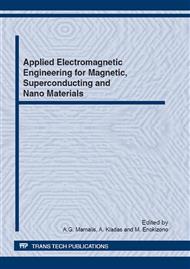[1]
B.V. Jayawant, Electromagnetic levitation and suspension techniques, Edward Arnold, London, 1981.
Google Scholar
[2]
N. Kurita, T. Ishikawa, and Y. Okada, Development of Lorentz Force Type Magnetic Bearing, Materials Science Forum, Vol. 670 pp.455-465, (2010)
DOI: 10.4028/www.scientific.net/msf.670.455
Google Scholar
[3]
T. Ohji, T. Shinkai, K. Amei, and M. Sakui, Application of Lorentz force to a magnetic levitation system for a non-magnetic thin plate, Proceedings 4th Japanese-Mediterranean Workshop, Cairo, (2005)
DOI: 10.1016/j.jmatprotec.2006.03.046
Google Scholar
[4]
K. Oka and T. Higuchi, Magnetic Levitation System by Reluctance Control: Levitation by Motion Control of Permanent Magnet, International Journal of Applied Electromagnetics in Materials, Vol. 4, pp.369-375, 1994.
Google Scholar
[5]
K. Oka and F. Sun, Zero Power Control for Mechanical Magnetic Suspension System Using Spring Force, Proceedings of 6th Japanese-Mediterranean Workshop, Bucharest, pp.251-252, (2009)
Google Scholar
[6]
T. Mizuno, Y. Hirai, Y. Ishino and T. Misuno, "Flux-Path Control Magnetic Suspension System Using Voice Coil Motors", Journal of System Design and Dynamics, Vol.1, No.2, pp.147-158, (2007)
DOI: 10.1299/jsdd.1.147
Google Scholar
[7]
T. Ueno, J. Qiu, J. Tani, "Magnetic Force Control Based on the Inverse Magnetostrictive Effect", IEEE Trans. on Magnetics, Vol.40, No.3, pp.1601-1605, (2004)
DOI: 10.1109/tmag.2004.826626
Google Scholar
[8]
F. Sun, K. Oka, and Y. Saibara, "Magnetic Suspension System by Flux Path Control Using Rotary Actuator", Proceedings of 14th International Symposium on Applied Electromagnetics and Mechanics, pp.289-290, Xi'an, China, 2009.
DOI: 10.3233/jae-2010-1184
Google Scholar
[9]
N K. Ikuta, S. Makita and S. Arimoto, Non-Contact Magnetic Gear for Micro Transmission Mechanism, Proceedings of the 1991 IEEE Micro Electro Mechanical System, pp.125-130, Nara, Japan, (1991)
DOI: 10.1109/memsys.1991.114782
Google Scholar
[10]
Y. Okada, H. Miyazawa, R. Kondo and M. Enokizono, Proposal of Flux Concentrated Radial and Axial Magnetic Bearings, Materials Science Forum, Vol.670, pp.435-446, (2010)
DOI: 10.4028/www.scientific.net/msf.670.435
Google Scholar
[11]
Feng SUN and Koichi OKA, Noncontact Spinning Mechanism Using Rotary Permanent Magnets, IEEJ Transactions on Industry Applications, Vol.130, No.7, pp.913-919, (2010-7)
DOI: 10.1541/ieejias.130.913
Google Scholar
[12]
Y. Fujiwara, T.S. Cui, L Chen and K. Oka, "Manipulation by Linear Driving Permanent magnet -Rotation Control of Ironball-", Journal of the Japan Society Applied Electomagnetics and Mechanics, Vol. 14, No. 1 pp.126-131, 2006, (in Japanese)
Google Scholar
[13]
Feng SUN, Akira TSURUMI and Koichi OKA, Torque Analysis of a Noncontact Spinning System Using Linearly Actuated magnets, Proceeding of Asia-Pacific Symposium on Applied Electromagnetics and Mechanics 2010, pp.108-109, Kuala Lumpur, Malaysia, (2010-7).
Google Scholar
[14]
ELF Corporation, http://www.elf.co.jp/
Google Scholar


